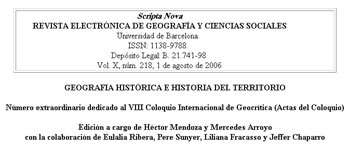Reconfiguring indígenous territory and legislation in Mexico
Keywords:
territory, territoriality, indigenous peoples, autonomyAbstract
Indigenous territories and territorialities have been subjected to a continuous process of reconfiguration throughout Mexico’s history; a process that began with a series of juridical dispositions and ordinances in the Colonial Period that have continued right up to modern times. One recent example of this is the set of juridical modifications that was ratified in 1992; designed, once again, to disarticulate collective properties and encourage privatization and the concentration of lands in only a few hands. However, there are also international dispositions that attempt to create a legal framework which recognizes and protects the lands of indigenous peoples; including the International Labor Organization’s (ILO) Convention #169, which was ratified by the Mexican government. At the national level, important referents exist to account for indigenous people’s ongoing resistance to eviction from their territories, and their struggle to gain recognition of a specific set of rights as culturally-specific collectivities, such as the so-called San Andrés Agreements. For indigenous peoples, territory constitutes the very material support of their communitarian way of life, as well as serving as a symbolic referent for their collective identity.Downloads
Published
2007-05-04
Issue
Section
Articles
License
Los autores que publican en esta revista están de acuerdo con los siguientes términos:
- Los autores conservan los derechos de autoría y otorgan a la revista el derecho de primera publicación, cin la obra disponible simultáneamente bajo una Licéncia de Atribución Compartir igual de Creative Commons que permite compartir la obra con terceros, siempre que estos reconozcan la autoría y la publicación inicial en esta revista.
- Los autores son libres de realizar acuerdos contractuales adicionales independientes para la distribución no exclusiva de la versió de la obra publicada en la revista (com por ejemplo la publicación en un repositorio institucional o en un libro), siempre que se reconozca la publicación inicial en esta revista.





